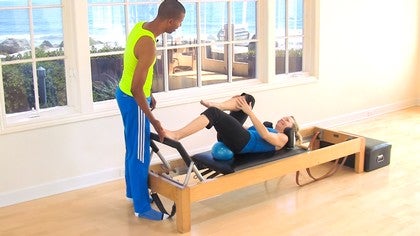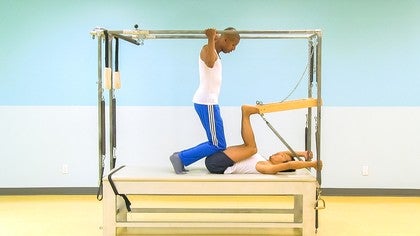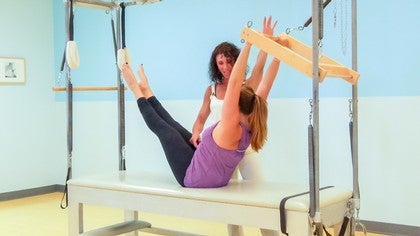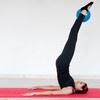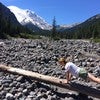Description
About This Video
Transcript
Read Full Transcript
The following example is an example of Romanos asymmetrical movement patterning. So I'm going to do footwork series and Amy actually has an injured, right? Ah, sorry, left knee and a, what we're going to do is we're going to do foot work and we're going to treat this knee. So that's what have been done after foot work. So I'm going to actually take it to two springs, which I have it on and I'm going to bring it into parallel position. And now lift your heels very high.
And so since this is your left knee that's injured, I'm going to have you bring your right knee into the chest and give yourself a nice hug there. So then this leg is not going to be working. I'm going to have you extend the leg good and bend the knee and come back in and extend to and come back in out on three, pulling in out on four, pulling in very nice out on five and let's do five more and out and in. And two pulling in out on three, pulling in, out on for pulling in last time and out and come in. Great. Now let's go to the leg that's a little stronger than non injured leg and you're going to bring this leg out to 45 degrees. Great.
So then we're going to pump that up a little bit and now extending out and in and two and in out on three. Very nice. In out on four and in out on five more times and out and in and two and in out three, pulling in out four and in one more time out and come in. And let's go back to this leg. And you're going to bring this knee into the chest. Still remaining on that toe. And now let's do five on the side and go out and in and two and in out on three and in out four and in one more time out and come in.
So let's stay on this leg and let's go into the arch of the foot. I want you to wrap over like a bird on a perch and extend the leg. Yes. And come in, out on to pulling in out three, pulling in out on four and in out on five more times and out. And in very nice too and in and out and into more out and in. Less time, out and in.
And now let's go to the stronger leg on the arch. Then the left leg will extend out. Very nice out and in two and in three and in four and in out on five more times and out and in two and in out on three pulling in and four with vive. And I'll hold there. Let's go back to this leg and then you can bring this knee into the chest and let's do five more and go out an n n two. She was like, I'm hitting you right now. Three hen for one more time out.
Five. Good. Let's stay on this leg. Let's go onto the heel of the foot. Flexing the foot and good and going out an n n to n n three out on four and n out on five your knee. Okay. Out on six n n out on seven and n out on eight an n twice more, nine an n last time, 10 and in good. Let's go to the stronger leg on the heel. Flexing the foot. Nice. And going out an n and two an n the maybe just a little softer.
This is more soft than that knee. Yes. In and out. An n out and end. Let's do three more out and in two more out and in last time out and n. And then last time let's go on to the heel and then right knee into the chest. Good.
And going out and come in two and in three an m n four and okay. And last time five and come all the way in. Great. So what I did with Amy since her left me with the one that was a little bit more injured, um, I decided to pump that leg up a little bit. So what I did is I did 10 repetitions on the weaker leg and then this leg had been into the chest. So then she wasn't using that leg. Then when we went onto the other side, I decided to extend this leg out to 45 degree angles so then she can really start to work that quad.
And then we went back to the side that was weaker and I had it back on the foot bar and then we did five more with this knee still bent into the chest. That way we didn't have to, um, that way this lake could gets stronger than this leg would not get to overworked because both legs are actually working. This leg when it's pressing out and in, that's going to be working when this leg is out at a 45 degree angle, that's also working. And so then if I would extend this leg out at 45 degrees, I'd actually be working both. So by bending the knee into the chest, I'm really just concentrating and focusing on the weaker leg side. That means to be worked more [inaudible]. We're going to do pelvic lift and this is an exercise I actually did a lot with Romana because I had a bad knee and it really focuses on the hamstring and it goes a similar type of asymmetrical pattern where I'm going to focus on one leg that I'm gonna focus on the other leg and then go back to the leg. That might be injured.
So let's have that left leg be the injured leg since it really is. And then, uh, what I'm gonna have you do is I'm gonna have you crow your head. Great. Now let's make a prayer position underneath your hips. And that way we know we have the right measurement there. Now Ramana sometimes would do this on the arches, sometimes she would do it on the heels, depending on the individual. So I'm actually gonna do this one with you on the heels. Great.
And now what you're going to do is you're going to keep this leg on and you're going to bring this knee into the chest and you can remove the hands now and give yourself a little hug of your knee and then try to keep the same relationship and you're going to extend the leg out. And this puts going to be flex. Good. And Ben in come in. Now you go out to where you can. So eventually we got to a full extension, but we went to where we could, cause we wanted to keep it up into the hamstring. If it went behind the back of the knee, she would tell us to not go any further. Let's do two more out and in, one more time out and come in. Perfect.
And now let's go on to the strong side. And then this one, I'm actually gonna have you extend the leg out to a 45 degree angle. Great. And now extending out and in and out on two and maybe just a little lower here, three there ago and in and out and in. Yes, when we're time out and come in. Great. And now let's go back onto this leg right in the arch and bend the knee back into the chest. And let's do five more out and in. And you can really feel that in the back of your leg and in and out and into more out and in.
Last time out and come in and great. And I'll bring both feet on, roll down through your spine. And Ramana did that on two springs and then once you are stronger, she would say no, try it on one spring. And then remember when you're doing this, you don't have to go all the way out. You go to just where you can control it or where it's comfortable, where it's really in your hamstring and it's not going to go behind the back of the knee or into your cap. Okay? So once again, you're going to roll up perfect. And now, yes, let's bring your right knee into the chest and go out to your comfort level. Good. And come in and you could feel the difference on two in one springs, right? And again, out much different, right? Yes.
Two more. And again, give that leg a hug. Three and in, great. Let's switch sides. You're going to bring this leg out to 45 and let's have a nice flex here and in two maybe this one needs it as well. And three [inaudible] and four and in one more time, five and in. Now let's go back to this leg. Bring this knee into the chest and let's just do five more.
Go out and in and two and in one more time, three, two more actually in and out and in last time out and come in grape both feet on and then roll down through your spine. One Vertebrae at a time. So that's how Vermont have taught it. I actually took it a little bit further myself and I like to use a ball because a lot of when people do with one leg they get a little bit of a rotation in their pelvis. So I like to put the ball underneath their pelvis so then they can feel that their pelvis is rotating and gives feedback. So roll your hips up great.
And you're just going to rest on that ball right there. And so then you can feel if you have more weight on this side or if you have more weight on that side. And the goal was to make sure that ball keeps its form and that there's equal weight always on both sides. So let's just do one just to do that. Great. And now going out and come in and then you can feel if there's any sort of weight transferring.
Cause it gives you a lot more feedback of where your pelvis is in space. Let's just do one more cause I know that you're a little bit tired and we don't have to do the other side just to show how I would work with the ball. So I'm going to have you lift up, roll down and that is pelvic lift on one leg. And it's another example of how vermano would work asymmetrically where she would focus on a weak leg, go back to the strong side and then go back to the weak side. And sometimes it's weak, strong, weak. Sometimes it was tight, loose, tight. So depending on the individuals, depending on when she decided to use her asymmetrical movement patterning.
And we're going to do pumping one arm. So I'm going to have you lie down and Ramana would always make us go to the lowest rib and not the lowest rib here, but actually the lowest rib on the side there. So then we can really work through our rib cage. And so with you, Amy, uh, I noticed that you have this part that's a little bit sunken down. So I'm actually going to try to pump this side up a little bit and that also will help that rib there. So I'm, how do you bring your left hand behind your back. There we go. Now I'm gonna bring my hand here. And when you bend your elbow, don't yet pull away. Yup.
Bend the elbow and then stretch the arm and hold for three, two, one. And then end pressing hold two, three, one more time. Bend and pressing. Hold two, three. Now bring this hand on. And since we're gonna focus on getting this out a little stronger, let's bring the right arm out to the side and Ramonda sometimes to bring a her hand here and she's a push down on my hand. And so that also would get that to activate more present hold. Or she'd say, push my hand away. And again, bend and pressing hold. Pull up through that. Right? So the ribcage more. Yes. And one more time bend and pressing hold. Hold, hold. Good. Let's go back to the side.
I want to strengthen a little bit more of a right hand on left hand behind the back. Just so we don't work that side. And you're going to shift your rib cage a little bit to your left. Good. And again, bend, pressing, hold two, three, and again. Then present. Hold two, three, do one more. And as you press and hold, pull away from my hand. There we go. Two, three, and now both hands on and you can stand up. And that is another example of Romanos asymmetrical movement patterning.
And that is with pumping one arm.
Pilates Legacy Project - Playlist 4: Romana Kryzanowska Methods
Comments
You need to be a subscriber to post a comment.
Please Log In or Create an Account to start your free trial.
